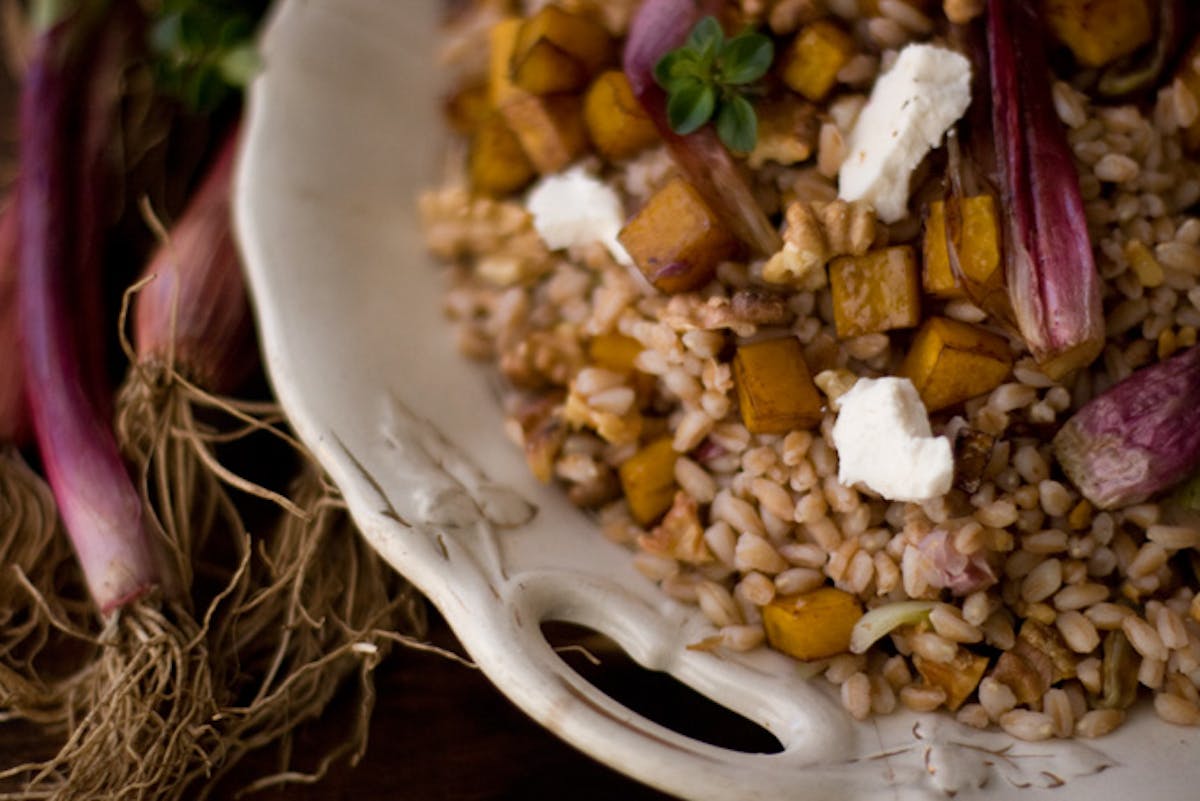A Few Favorite Whole Grains
A list of a few of my favorite whole grains to cook with - from barley to farro, wheat berries to millet and teff, and more.

Each batch of grains has a personality all its own, so keep in mind there are no absolutes, only approximates when you go to cook them. Cooking times are always approximate and will vary based on how long it has been since a grain was harvested, the size of the grains, and even the characteristics of the water in your area. If you are opting to used pearled grains to cut back on cooking times (yet still benefit from a semi-whole grain), the amount of pearling will impact cooking time as well.
This is a list of a few of my favorite grains to cook with, a list that is by no means meant to be comprehensive or encyclopedic in nature - simply a few friends I revisit time and time again.
A Few Fast-Cooking Grains:
Cooking in under 30 minutes, all of the grains described below can easily be incorporated into your repertoire. Most of these cook quickly because they're small, and their compact size also lends them an impressive nutrient profile. Because they don't have much room for starchy endosperm, small grains contain a much higher percentage of nutrient-rich hull and germ.
Amaranth: Not a grain in the strictest sense, amaranth is actually the seeds of an herb indigenous to the Americas. The tiny seed packs a flavor punch that belies its miniature stature, and its lysine-rich, 16 percent protein profile makes it a nutritional darling to boot. Amaranth has a texture that pops in the mouth and a pronounced green spiciness that aligns it more closely in flavor to quinoa than to some of the other true grains, like wheat and oats. Many recipes can benefit from its addition, from biscuits and pancakes to tart crusts and granola bars. I include a few amaranth recipes in Super Natural Cooking.
Millet:: Millet is painfully underutilized. These perfect, delicately textured, butter-colored beads are as good for you as they are pretty. Easy to digest and sporting a fantastic heart-healthy magnesium content, millet is a great, quick-cooking starter grain. If you have the time for the extra step, the flavor of millet generally benefits from pre-toasting, easily done in a skillet. It brings forth a nutty flavor and tints the grains a wonderful spectrum of deep yellows and light browns. The light texture and mild flavor of millet pairs nicely with fresh alliums, such as chives, green onions, and spring garlic. Look for it in the bins at most natural food stores or try Whole Foods Markets. I've featured a couple millet recipes here on the site, and look forward to more.
Oats:The ultimate morning grain, oats are available in a few different forms. Whole oat berries (or groats) are equivalent in size to wheat berries, but they cook up to twice as fast and are naturally sweeter, lending themselves nicely to spicy, sweet, salty, and fruity preparations. Steel-cut oats are created by cutting the groat down into smaller pieces. Old-fashioned rolled oats are produced by steaming whole groats and rolling them to varying thicknesses. Instant oats are simply the thinnest or most finely cut oats. All of these variations are considered whole foods. There are quite a few oat recipes here, and be sure to keep your eyes peeled for out flour as well.
Quinoa: Cooking quinoa is easier than trying to figure out how to pronounce it (KEEN-wah). This small, quick-cooking grain bullied me into first purchasing it years ago with a nutritional profile I couldn't ignore. High in easy-to-digest fiber and tops in protein, it has an encyclopedic vitamin and mineral profile and is positively brimming with properties thought to promote cardiovascular health, stave of certain cancers, tame headaches and migraines, provide antioxidant protection, and on and on. This is the grain credited with keeping Incan armies strong and resilient. Because the protein in quinoa is considered complete, it's an ideal grain for vegetarians concerned about getting enough protein. It includes all of the essential amino acids and is a rich source of the amino acid lysine, which promotes tissue growth and repair and supports the immune system. While I initially purchased this grain for its nutritional perks, I kept buying it for its grassy taste and fluffed-up, creamy-while-crunchy texture. It grows in a spectrum of reds, browns, and pinks, but shades of ivory or deep red predominate in U.S. markets. Use quinoa in salads and stuffings or to add texture to quick breads and cookies. Always rinse it before using to remove the bitter saponin coating (which the plant produces to deter birds and insects). Technically not a true grain, it is related botanically to Swiss chard and beets, but it is grainlike in spirit when it comes to cooking. I have a bunch of quinoa recipes here on the site, and a few in Super Natural Cooking as well.
Teff:One of the mightiest of the mini grains, teff (also spelled tef or t'ef) is the staple grain of Ethiopia. Because it's rich in iron, it's credited with establishing Ethiopians as the best long-distance runners in the world. How can such a small grain pack such a punch? There's only room for the nutrient-rich bran and germ and not much else. I use teff in tart crusts and pie crusts, in place of cornmeal in polenta, and in a range of baked breads, cakes, and muffins. It is a very dignified-looking grain available in a deep, rich, reddish brown chestnut color or a classic ivory tone. For added depth of flavor when using teff, toast the raw grains for a few minutes in a dry pan--just until fragrant. Here is a great teff recipe, and there are two others in Super Natural Cooking.
Slower-Cooking Grains:
Don't swear off slower-cooking grains just because they aren't as convenient. With a bit of advance planning, you can cook them up in ahead of time, on the weekend, or in a slow cooker and then utilize them on the fly throughout the week.
Barley: I often use barley as the foundation for my risotto recipes. Whole barley takes a long time to cook, so I search out barley that has had its nutrient-rich bran coating only lightly pearled off. Pearling simply buffs off a variable amount of the outer bran coating, but certainly not as much as a fully refined grain, let's call it semi-whole. Choose bigger grains over smaller ones that have been pearled down too far. If you have the time hulled barley (considered whole) can be used, but this will increase your cooking time significantly. Barley thickens up stews beautifully and absorbs surrounding flavors nicely. Barley recipes.
Farro: Trendy, health-conscious chefs have helped make the ancient grain farro quite popular over the past few years. It was one of the first domesticated grains in Mesopotamia before other cereal grains took over as preferred grain crops. Farro has been enjoying a resurgence in interest not only because of its nutritional profile, but also because it is hearty and deeply satisfying and pairs nicely with a fantastic range of seasonal ingredients year-round. Like barley, farro can be used as an alternative grain for risotto-type dishes, and is often found slightly pearled. When shopping, look for Triticum dicoccum, farro's Latin name. If you can't find farro for a recipe, substitute barley and cook until tender--typically taking less time than farro. Farro recipes.
Wheat berries: This might strike some of you as obvious, but when you grind up a wheat berry, you get flour. Hard red winter wheat berries end up as higher-protein bread flours, while lower-protein soft wheat berries are ground into pastry or cake flours. Because they contain the bran and germ, all wheat berries are nutritionally intact. I typically opt for soft wheat berries at the market because they cook up into plump, chewy grains that are well suited for salads, soups, or simply seasoned on their own. Wheat berries are notorious for marathon cooking times, so if you want to save some time, soak the berries in water for a few hours or overnight prior to cooking. Cracked wheat is simply the result of cracking the wheat berries between rollers. Cracked wheat is still nutritionally intact and much quicker to cook, but completely different in terms of how you might use it. If you've had a side dish of tabouli, you've had cracked wheat, and you'll be able to all of its other potential applications: as a rice substitute, instead of oatmeal in the morning, or to add texture and flavor to baked goods.
Wild rice: You've heard it before: wild rice isn't actually rice; it's an annual aquatic grass, and an underutilized one at that. Its distinctive nutty flavor, hearty texture, and captivating earthy colors should make it a prime candidate for frequent use beyond holiday stuffing recipes and the occasional cranberry-flecked side dish. Its nutritional benefits are legendary and a broad spectrum of wild rice is available, coming not only from its native upper Great Lakes region but from California, Washington, and Idaho as well. There are both hand-harvested and cultivated wild rices. Connoisseurs will be quick to tell you that wild rice hand-harvested from a canoe is like a fine wine. Hand-cultivated wild rice is the crème de la crème, but it isn't within everyone's budget. It can be surprisingly light in color and often takes much less time to cook than its cultivated cousin, the much darker, glossy, brownish black wild rice you are likely familiar with. It's also more likely that hand-harvested wild rice hasn't been raised with harsh agrochemicals. That being said, I've had delicious cultivated wild rice too; much depends on the influence of the environment in which the rice is grown (think terroir), how the rice is harvested, and how it is processed. Whether you are buying hand-harvested or cultivated wild rice, price and quality varies greatly. It is certainly worth the effort to find a good source. As with most grains, cooking time can vary greatly depending on the type of wild rice you buy, when it was harvested, and how much moisture is left in each rice grain by the time you bring it home. If you want to get even more earthy, nutty flavor out of your wild rice, it just takes a bit of extra time and tenacity. After cooking the rice, drain it and toss with a bit of clarified butter. In a wide, shallow baking dish (or on a rimmed baking sheet) pop it in a 375F degree oven until fragrant. This brings out a whole new dimension of flavor from the grains and is worth the effort if you are showcasing the rice in a salad or for simple preparations. I don't typically make that extra effort if I'm using the wild rice in a soup or for textural backdrop. Wild rice recipes.


